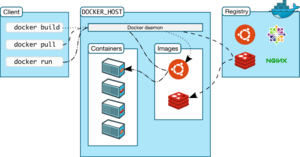Difference between revisions of "Docker"
(updated) |
|||
| Line 1: | Line 1: | ||
| − | Linux containers (LXC)<ref>https://help.ubuntu.com/lts/serverguide/lxc.html</ref> technology has taken off with Docker https://www.docker.com/ <ref>[http://opensource.com/business/14/7/interview-j%C3%A9r%C3%B4me-petazzoni-docker See the interview on opensource.com]</ref> <ref>more info from Wikipedia [[wp:Docker_(software)]]</ref> which was released as open source in March 2013. RedHat and others have collaborated with the corporate backer to the technology seemingly to compete with Canonical's JuJu https://juju.ubuntu.com/ and Charm technology which also is based on Linux containers. Linux containers are built into the linux kernel, and so offer a lightweight native method of virtualization compared to more traditional (heavyweight) virtualization techniques like VMWare, Vagrant, VirtualBox. | + | [[File:Docker-architecture.svg|thumb|right|Docker Architecture|link=https://docs.docker.com/get-started/overview/#docker-architecture]] |
| + | Linux containers (LXC)<ref>https://help.ubuntu.com/lts/serverguide/lxc.html</ref> technology has taken off with Docker https://www.docker.com/ <ref>[http://opensource.com/business/14/7/interview-j%C3%A9r%C3%B4me-petazzoni-docker See the interview on opensource.com]</ref> <ref>more info from Wikipedia [[wp:Docker_(software)]]</ref> which was released as open source in March 2013. RedHat and others have collaborated with the corporate backer to the technology seemingly to compete with Canonical's JuJu https://juju.ubuntu.com/ and Charm technology which also is based on Linux containers. Linux containers are built into the linux kernel, and so offer a lightweight native method of virtualization compared to more traditional (heavyweight) virtualization techniques like [[VMWare]], [[Vagrant]], [[VirtualBox]]. | ||
| − | Essentially, the difference is the hypervisor and OS. Whereas containers are implemented with kernel features like namespaces, cgroups and chroots, a full VM requires a hypervisor plus an operating system in the VM. | + | Essentially, the difference is the hypervisor and OS. Whereas containers are implemented with kernel features like namespaces, cgroups and chroots, a full VM requires a hypervisor plus an operating system in the VM. Docker runs a [https://docs.docker.com/get-started/overview/#docker-architecture docker daemon] on the Docker Host. |
| − | |||
{{Video|url=https://www.youtube.com/watch?v=YFl2mCHdv24}} | {{Video|url=https://www.youtube.com/watch?v=YFl2mCHdv24}} | ||
{{Video|url=https://www.youtube.com/watch?v=Qw9zlE3t8Ko}} | {{Video|url=https://www.youtube.com/watch?v=Qw9zlE3t8Ko}} | ||
| − | + | * https://docs.docker.com/develop/ | |
| − | + | * https://docs.docker.com/engine/install/ | |
| − | |||
| − | |||
| − | |||
| − | |||
| − | |||
| − | |||
| − | |||
| − | |||
| − | |||
| − | |||
| − | |||
| − | * | ||
| − | |||
| − | |||
| − | |||
| − | |||
| − | |||
| − | |||
| − | |||
| − | https://docs.docker.com/engine/ | ||
| − | |||
{{References}} | {{References}} | ||
Revision as of 18:33, 5 August 2020
Linux containers (LXC)[1] technology has taken off with Docker https://www.docker.com/ [2][3] which was released as open source in March 2013. RedHat and others have collaborated with the corporate backer to the technology seemingly to compete with Canonical's JuJu https://juju.ubuntu.com/ and Charm technology which also is based on Linux containers. Linux containers are built into the linux kernel, and so offer a lightweight native method of virtualization compared to more traditional (heavyweight) virtualization techniques like VMWare, Vagrant, VirtualBox.
Essentially, the difference is the hypervisor and OS. Whereas containers are implemented with kernel features like namespaces, cgroups and chroots, a full VM requires a hypervisor plus an operating system in the VM. Docker runs a docker daemon on the Docker Host.
References[edit source]
- ↑ https://help.ubuntu.com/lts/serverguide/lxc.html
- ↑ See the interview on opensource.com
- ↑ more info from Wikipedia wp:Docker_(software)
